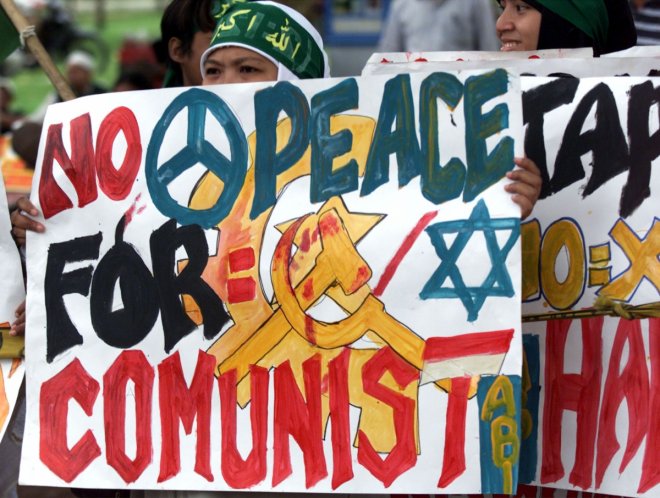
Part 2 of a series: Indonesia’s Forgotten Genocide
[hr]
By Ariq Hatibie
[divider]
[dropcap]N[/dropcap]early 30 years have passed since the fall of the Soviet Union, the disintegration of Yugoslavia, and the transition of China into state-led capitalism. Yet despite pummeling communists into oblivion in 1965, Indonesia remains immersed in a perpetual red scare, paranoid about the resurgence of the Communist Party (PKI). Just two months ago, the Indonesian military confiscated over a hundred books connected to the PKI in the city of Kediri. Just one month ago, the Attorney General, backed by the Defense Minister, suggested a widespread literary crackdown. Indonesia has seen two decades of democracy since Suharto’s fall, yet the specter of communism, that nebulous poltergeist which plunged many a nation into mass hysteria and has largely vanished since the end of the Cold War, continues to haunt the archipelago.
Much of this stems from the military’s iron grip on the narrative surrounding the Indonesian Genocide. Suharto and the military portrayed a failed and uncoordinated coup attempt (G30S) as an impending mass murder planned by the PKI. Banning pro-PKI and pro-Sukarno newspapers, state press called for pogroms against the organization. One of their stories told of members of Gerwani (the women’s organization in support of the PKI) dancing naked in front of generals abducted during G30S, cutting off their genitals, and gouging out their eyeballs before tossing them down a well. Farfetched as this was, the lack of press opposition allowed narratives like these to fester, giving just cause for mass murder and forming the bedrock of many conservative New Order ideologies, such as that which treated women as sexually ferocious beings in need of domestication (more on this in my next piece).
The military’s elaborately crafted myths cemented absolute ideological control during Suharto’s New Order regime from 1966-1998, suppressing the left on all fronts. Suharto banned labor movements, replacing them with the state-run Serikat Pekerja Seluruh Indonesia (SPSI). Artists connected to the left suffered. One of Indonesia’s most celebrated writers, Pramoedya Ananta Toer, was arrested for alleged connections to the PKI. Batik artists (makers of Indonesia’s trademark national dress) such as Mohammad Hadi were detained for being members of Lekra (the Institute of People’s Culture), which promoted class-conscious art. Anyone with vaguely left-leaning ideals risked prison time or death. The foundation of the New Order lay in its self-portrayal as the savior of the nation from communist takeover. After the Genocide, Suharto and the military used the threat of PKI resurgence to stymie leftist political movements and indeed any threat to the New Order, curtailing even the Islamists who ran amok during the Genocide itself. The romance with the US, the Cold War’s ultimate communist crusader, manifest in deals conceding natural resources; American-educated economists like the “Berkeley Mafia”; and direct links with the CIA, incentivized and strengthened anti-leftist rhetoric as a means for climbing the bureaucracy and for tightening power.
What does the desecration of the left imply for modern Indonesia? While centre-left parties like the PDI-P have found significant success—such as that members Megawati and Joko Widodo have become president—widespread paranoia remains towards those further out on the political spectrum. A statute passed in 1999 (see article 107a) criminalized the dissemination of Marxist-Leninist thought, punishing violators with up to 12 years in prison. In 2016, the police arrested a farmer for wearing a shirt with a hammer and sickle. In 2017, they detained a Malaysian tourist for the same thing. The absurdity of such cases illustrates the sheer magnitude of fear towards leftist political ideologies.
The most lamentable consequence of this paranoia is the inability to bring the truth of the Genocide to light. To this day, history textbooks neglect to mention the killings. The state-sponsored History of Indonesia, written by the regime’s historians, contains only one sentence mentioning localized violence in Bali and East Java. In Joshua Oppenheimer’s documentary, The Look of Silence, a former death squad commander not only dodged questions regarding his responsibility for the killings, but also questioned the documentarist and the interview’s political allegiances. As Vedi Hadiz has noted, villages have been torn asunder during the Genocide, when ordinary civilians killed members of their own community and have subsequently been told by the New Order to be wary of their descendants. The consequences of this intergenerational animosity emerge in episodes such as village protests against reunions of ex-political prisoners of the Genocide. Such instances reflect the difficulties for survivors, who are reaching the end of their lives, to speak about their experiences.
Subjugating typewriter, pen, and paintbrush, the New Order successfully locked the archipelago into a Red Scare that persists to this day. What does it say about a democracy, that 15,000 protestors have forcefully prevented survivors of the massacre from meeting and rallied under the slogan “reject the PKI”? What does it divulge about the consequences of genocide, that the military’s Commander General has recently tried to mandate the showing of the 1984 New Order Propaganda film, The Treachery of the September 30th Movement? What does it reveal about a nation, that those lucky enough to have survived a genocide must live their last days in silence? When the military extinguished the communist threat, they expunged an entire intellectual tradition. As much as the Genocide claimed the lives of hundreds of thousands, it birthed a black hole in the otherwise vibrant constellation of political thought that resurged after Suharto’s fall, leaving a robust and unending void in the Indonesian consciousness.
[hr]
Ariq is a junior in Grace Hopper. You can contact him at ariq.hatibie@yale.edu.